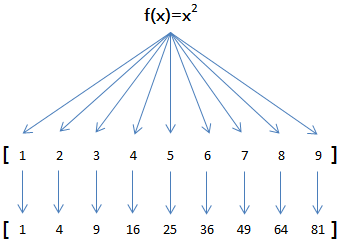Heim >Backend-Entwicklung >Python-Tutorial >Python中的map()函数和reduce()函数的用法
Python中的map()函数和reduce()函数的用法
- WBOYOriginal
- 2016-06-10 15:14:171612Durchsuche
Python内建了map()和reduce()函数。
如果你读过Google的那篇大名鼎鼎的论文“MapReduce: Simplified Data Processing on Large Clusters”,你就能大概明白map/reduce的概念。
我们先看map。map()函数接收两个参数,一个是函数,一个是序列,map将传入的函数依次作用到序列的每个元素,并把结果作为新的list返回。
举例说明,比如我们有一个函数f(x)=x2,要把这个函数作用在一个list [1, 2, 3, 4, 5, 6, 7, 8, 9]上,就可以用map()实现如下:

现在,我们用Python代码实现:
>>> def f(x): ... return x * x ... >>> map(f, [1, 2, 3, 4, 5, 6, 7, 8, 9]) [1, 4, 9, 16, 25, 36, 49, 64, 81]
map()传入的第一个参数是f,即函数对象本身。
你可能会想,不需要map()函数,写一个循环,也可以计算出结果:
L = [] for n in [1, 2, 3, 4, 5, 6, 7, 8, 9]: L.append(f(n)) print L
的确可以,但是,从上面的循环代码,能一眼看明白“把f(x)作用在list的每一个元素并把结果生成一个新的list”吗?
所以,map()作为高阶函数,事实上它把运算规则抽象了,因此,我们不但可以计算简单的f(x)=x2,还可以计算任意复杂的函数,比如,把这个list所有数字转为字符串:
>>> map(str, [1, 2, 3, 4, 5, 6, 7, 8, 9]) ['1', '2', '3', '4', '5', '6', '7', '8', '9']
只需要一行代码。
再看reduce的用法。reduce把一个函数作用在一个序列[x1, x2, x3...]上,这个函数必须接收两个参数,reduce把结果继续和序列的下一个元素做累积计算,其效果就是:
reduce(f, [x1, x2, x3, x4]) = f(f(f(x1, x2), x3), x4)
比方说对一个序列求和,就可以用reduce实现:
>>> def add(x, y): ... return x + y ... >>> reduce(add, [1, 3, 5, 7, 9]) 25
当然求和运算可以直接用Python内建函数sum(),没必要动用reduce。
但是如果要把序列[1, 3, 5, 7, 9]变换成整数13579,reduce就可以派上用场:
>>> def fn(x, y): ... return x * 10 + y ... >>> reduce(fn, [1, 3, 5, 7, 9]) 13579
这个例子本身没多大用处,但是,如果考虑到字符串str也是一个序列,对上面的例子稍加改动,配合map(),我们就可以写出把str转换为int的函数:
>>> def fn(x, y):
... return x * 10 + y
...
>>> def char2num(s):
... return {'0': 0, '1': 1, '2': 2, '3': 3, '4': 4, '5': 5, '6': 6, '7': 7, '8': 8, '9': 9}[s]
...
>>> reduce(fn, map(char2num, '13579'))
13579
整理成一个str2int的函数就是:
def str2int(s):
def fn(x, y):
return x * 10 + y
def char2num(s):
return {'0': 0, '1': 1, '2': 2, '3': 3, '4': 4, '5': 5, '6': 6, '7': 7, '8': 8, '9': 9}[s]
return reduce(fn, map(char2num, s))
还可以用lambda函数进一步简化成:
def char2num(s):
return {'0': 0, '1': 1, '2': 2, '3': 3, '4': 4, '5': 5, '6': 6, '7': 7, '8': 8, '9': 9}[s]
def str2int(s): return reduce(lambda x,y: x*10+y, map(char2num, s))
也就是说,假设Python没有提供int()函数,你完全可以自己写一个把字符串转化为整数的函数,而且只需要几行代码!
练习
利用map()函数,把用户输入的不规范的英文名字,变为首字母大写,其他小写的规范名字。输入:['adam', 'LISA', 'barT'],输出:['Adam', 'Lisa', 'Bart']。
Python提供的sum()函数可以接受一个list并求和,请编写一个prod()函数,可以接受一个list并利用reduce()求积。

